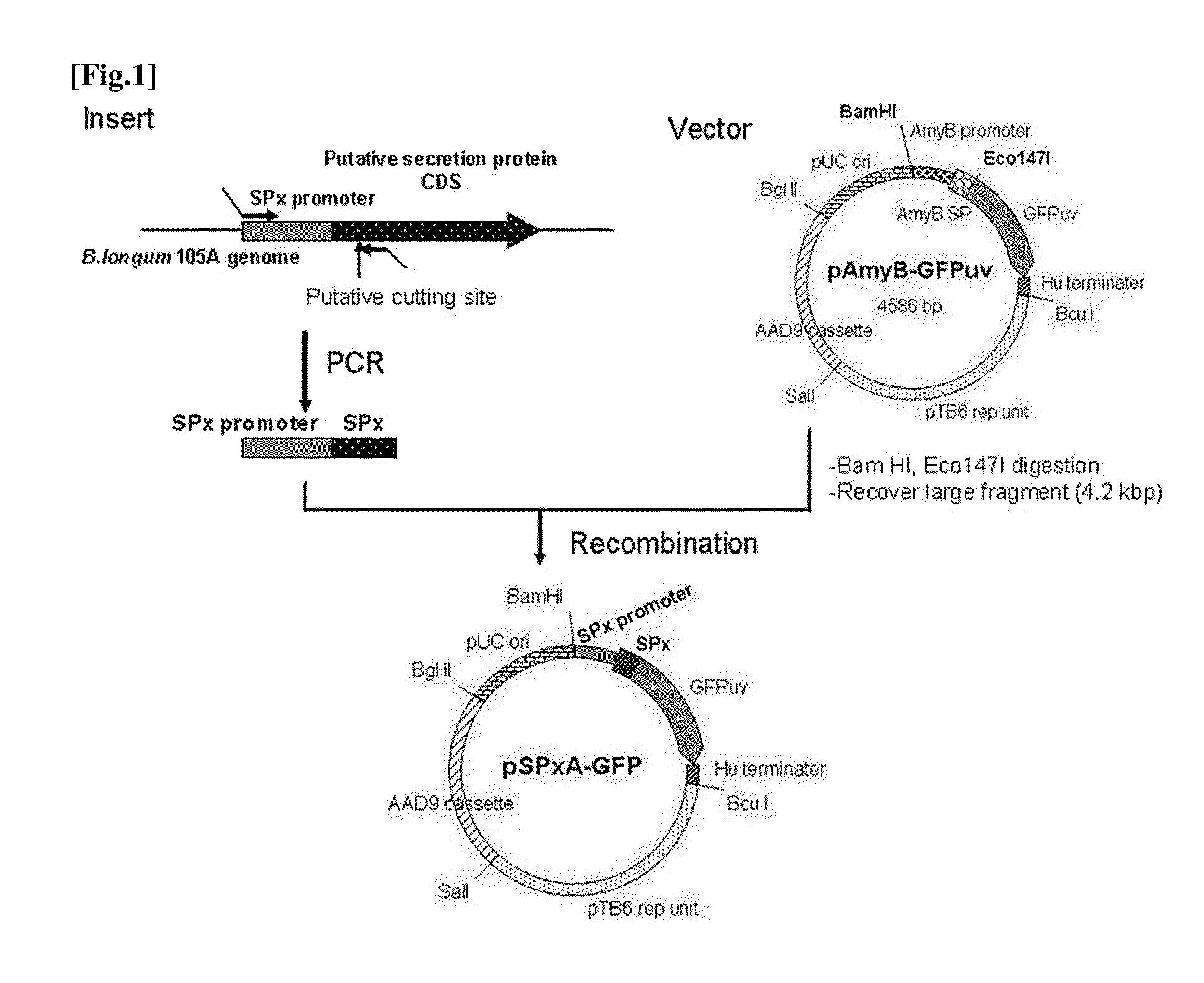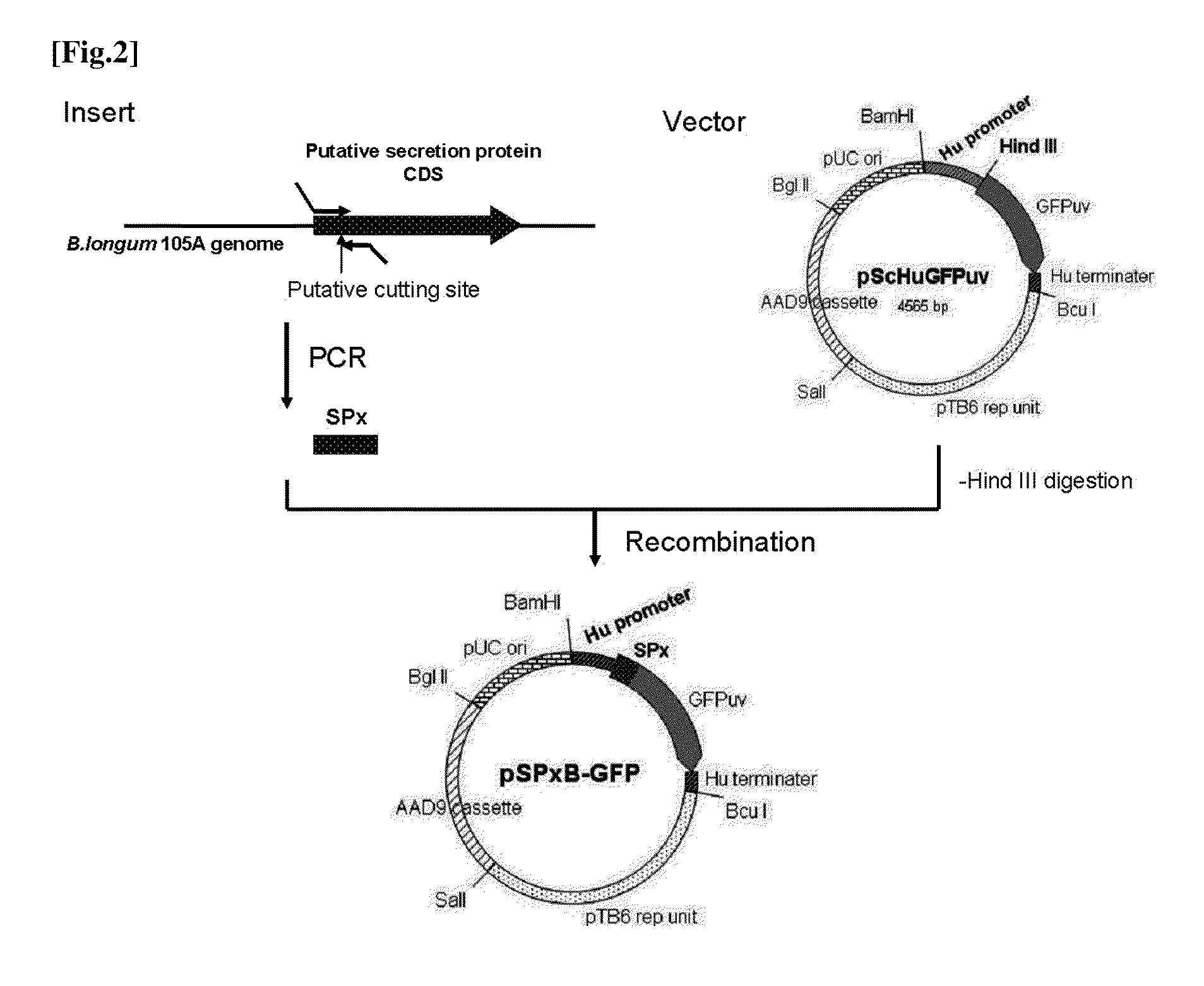Transfection vector
a technology of transfection vectors and vectors, applied in the field of transfection vectors, can solve the problems of back mutations, exerting harmful effects, and impossible to be denied, and achieve the effect of safe vectors
- Summary
- Abstract
- Description
- Claims
- Application Information
AI Technical Summary
Benefits of technology
Problems solved by technology
Method used
Image
Examples
reference example 1
In Silico Screening of Secretory Signals
[0143]For 1941 amino acid sequences in entire translational region predicted from the whole genome sequence of Bifidobacterium longum 105A, signal peptides prediction using PrediSi was performed and 188 signal peptides were predicted. The prediction employed a parameter set for Gram Positive Bacteria.
[0144]Among the 188 signal peptides predicted, 25 which did not have a transmembrane region were chosen as secretory protein candidates. Their putative secretory protein coding regions are shown in Table 1.
TABLE 1Positions and directions of secretory protein candidates in the genomeCandidate No.OperonPosition, direction1head20020 -> 209822head762462 -> 7637873head781649 -> 7825124head842877 -> 8445775head1433216 -> 14336506head1662965 -> 16642097head1917150 -> 19178368head164213 9head636847 10head752108 11head839663 12head1201317 13head1744372 14head1958176 15head2225694 16head2258216 17not head58769 -> 5988118not head471365 -> 47241119not head768...
production example 1
Construction of a Secretory GFP-Expressing Plasmid (pSPxA-GFP)
[0145]We constructed a plasmid that expresses secretory GFP by a promoter of a signal peptide candidate. A summary is shown in FIG. 1. Details are provided below.
Insert Preparation
[0146]Among the 25 secretory protein candidates, for 16 whose gene are located on the head of the operon (Table 1, Nos. 1 to 16), putative signal peptide portions comprising a promoter and 60 to 90 nucleotides downstream thereof were amplified by PCR method as described below.
[0147]Forward primers were designed 300 bps upstream of the translation start site and reverse primers were designed 60 to 90 bps downstream of the DNAs encoding the signal peptides. 30 ng of the genomic DNA of Bifidobacterium longum 105A was used as template for PCR using 2× Phusion Flash PCR Master mix (FINNZYMES).
[0148]The PCR program was as follows: 98° C. for 10 seconds, then 30 cycles of 98° C. for 1 second plus 55° C. for 5 seconds plus 72° C. for 9 seconds, and 72° ...
production example 2
Construction of a Secretory GFP-Expressing Plasmid (pSPxB-GFP)
[0160]A plasmid that expresses secretory GFP by histone-like promoter (HU promoter) of Bifidobacterium. A summary is shown in FIG. 2. Details are given below.
Insert Preparation
[0161]Among the 25 secretory protein candidates above, for 22 candidates (Nos. 1-16, 19, 21-25) excluding 3 (Nos. 17, 18, 20) that were assumed to be deficient protein coding sequences, DNA fragments containing the putative signal peptide coding parts and 60 to 90 nucleotides downstream thereof were amplified by PCR.
[0162]Forward primers were designed at the translation start site and reverse primers were designed at 60 to 90 nucleotides downstream of the DNA encoding the signal peptides. PCR primers for each signal peptide are shown in Table 2.2. 15 nucleotides at 5′ side of each primer have a homologous sequence to the vector shown below.
TABLE 2.2Primers for amplification of signal peptides (SPx)SequencePCRPrimer Name(5′ -> 3′)product 1SP1_F2_prim...
PUM
| Property | Measurement | Unit |
|---|---|---|
| Fraction | aaaaa | aaaaa |
| Fraction | aaaaa | aaaaa |
| Fraction | aaaaa | aaaaa |
Abstract
Description
Claims
Application Information
 Login to View More
Login to View More - R&D
- Intellectual Property
- Life Sciences
- Materials
- Tech Scout
- Unparalleled Data Quality
- Higher Quality Content
- 60% Fewer Hallucinations
Browse by: Latest US Patents, China's latest patents, Technical Efficacy Thesaurus, Application Domain, Technology Topic, Popular Technical Reports.
© 2025 PatSnap. All rights reserved.Legal|Privacy policy|Modern Slavery Act Transparency Statement|Sitemap|About US| Contact US: help@patsnap.com



